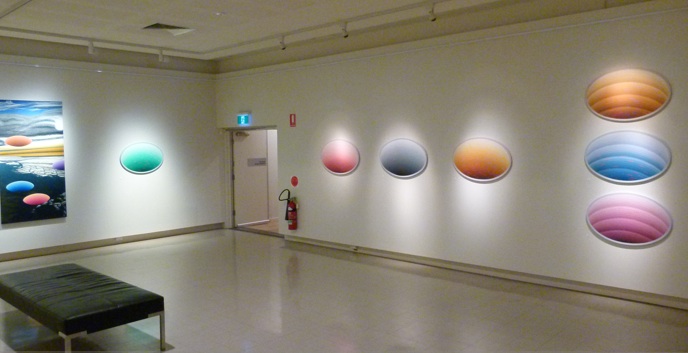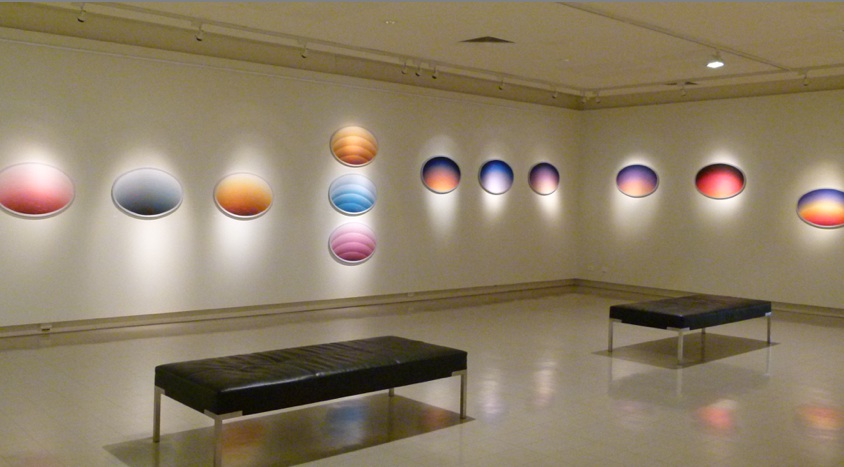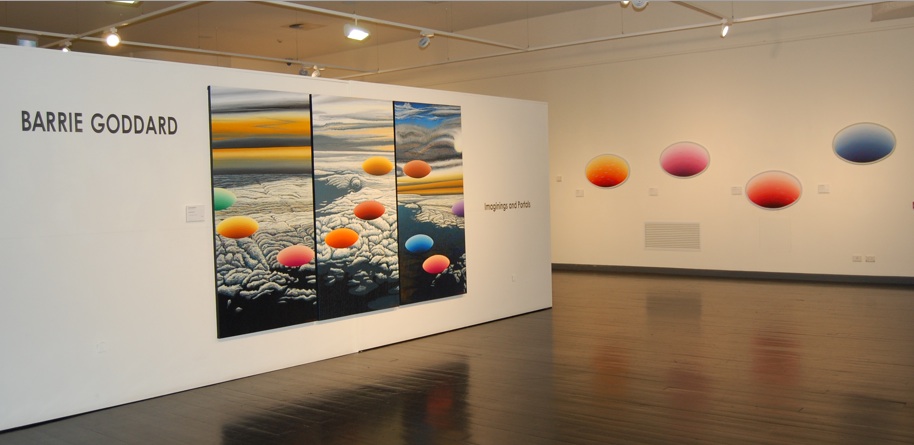|
Catalogue for Riddoch Regional
Gallery Mt Gambier, 2016
John Neylon is an Adelaide art
writer and curator
Prism
There are times in history when
the stars align and art and science discover each other like
long lost cousins. Goddard is a love child of such an era - the
Atomic or Space Age of the mid twentieth century - the launch
of Sputnik in 1957, pictures of the far side of the moon in 1959
and the landing of Apollo 11 on the moon in 1969. The Space Age
left a streamlined imprint on everything from architecture to
kitchenware, fashion, music and TV shows like The Jetsons.
A distinctive art and design aesthetic extrapolated in the 1950s
and 1960s - all glass, chrome and plastic, amoeba-like shapes,
split atom star bursts and Chevys sprouting rocket fins. The
Atomic Age wasn't all about the Cold War's threat of nuclear
annihilation. Post World War 11 optimism found expression in
Pop art's celebration of consumerism, the exuberance of abstract
expressionism and, as the 60s morphed into the 70s, a celebration
of optical razzle dazzle expressed in shape play, pattern and
bright, pure colour. For imagery that captures the spirit of
the era look no further than Pink Floyd's 1973 The Dark Side
of the Moon album cover of a prism dispersing light as colour
or Milton Glaser's 1966 poster of Bob Dylan with psychedelic
hair.
Colour was in the air when Goddard
undertook his art training at the South Australian School of
Art in the late 50s - early 60s. A brand of shape-colour ethos
underpinned design-based studies presented by Art School lecturers
Helen Macintosh, Meg Douglas and Geoff Wilson, introduced the
ideas of Paul Klee, Wassily Kandinsky, Joseph Albers and Victor
Vasarely and primed acceptance for a diversity of colour, shape-based
minimal art from Mark Rothko to Ellsworth Kelly, Kenneth Noland,
Frank Stella and Bridget Riley. Goddard was convinced at the
time that his creative journey should be grounded in some kind
of reality rather than become a superficial pursuit of the latest
trends. While the current day, bold chromatic, pattern-rich style
of expression carries the imprint of formative years, his imagery
is the product of a sustained engagement with the Australian
landscape as envisaged through the prism of his observant and
imaginative eye. What makes this engagement remarkable is that
it has always been set within a broad, cosmic context in which
the physical earth, with its topographies and geologies is redefined
by deep time and space. Goddard's early investigations were informed
in part by photographic illustrations and articles in the journal,
Scientific American. The first moon landing, satellites
tracking the earth and the excitement of the space race era provided
the context for bodies of work in which space became a metaphor
for altered states of consciousness. Suddenly the zone between
scientific time-space theories and diagrams on the one hand and
imaginative speculation and imagery narrowed. Goddard's first
publicly exhibited works, the Space Series (1969 - 1970)
explored related ideas. In works such as Solar Spin Off,
Mercuric Flight and Anti Matter Moves Out, the
artist 'floated' gravity free forms within visually disorientating,
diamond shaped canvases. A following Colour Form series
(1971- 74) embodied influences of 'Op' and 'Pop' styles (from
exhibitions seen in London and New York) plus the artist's first
contact with Islamic Art in southern Spain and Morocco. In this
series of paintings consisting of richly coloured regular forms
floating in space - chalices, cones and fans - a distinctive
motif of the shaft or void, began to assert itself. As Goddard
comments, 'My interest in ellipses, colour and illusion is paramount,
along with mines, shafts, sink holes and craters I have experienced
in my travels around Australia.'
Cut to the present. This current
exhibition consists of nineteen holes in space (complemented
by a large 'skyscape' painting Imagine Dreaming). Their
premise is absurd when considered within Goddard's entire practice
which has always been, apparently, about 'the big picture'. From
his earliest landscape studies, Goddard's instincts have gravitated
to the underlying structures and patterns of the earth's crust.
Underlying all his work is a sense of Australia as a vast, ancient
land in which the inexorable forces of nature are ever present
and reminders of fragility of humanity's hold on this place are
many. A favourite visual device to encapsulate this idea has
been striation or layering structures which not only document
specific geologies of such places as the Flinders Ranges and
the volcanic landscape of South Australia's lower south-east
but also recognise the inexorable cycles of time and cataclysmic
events which have the final say on what lives and what dies on
the planet. There is a corresponding sense of this in the artist's
many seascape subjects in which the metronomic beat of the sea's
immense energy lies barely below the surface.
Eighteen of the nineteen holes
in space are 'real' in the sense that they reference, 'The World's
Longest Golf Course'. Road travelers between Adelaide and Perth
have the option of playing the Nullabor Links - a series of golfing
holes spaced from Ceduna to Kalgoorlie. But as the paintings
titles, such as Lasseter's Labyrinth, Rinehart Red
- Lang's Legacy, Pilbara Pink - For Fred and Clive's
Coal face or Black Hole suggest, this nomads' playground
is a pretext for a set of ironic, whimsical and nostalgic reflections
on life as it continues to be served up in this wide brown land.
Equally as serendipitous are the titling and circumstance of
Imagine Dreaming. The 'view out the plane window' skyscape
is real enough. It came from an early morning flight, made by
the artist, from Adelaide to Ceduna. But at another level it
it is anything but. Goddard's eye was caught by the sun reflecting
off a FIFO worker's high vis jacket and his imagination by all
that this meant in terms of people journeying and working a long
way from home - and as miners.? Will Australia ever see itself
more that a hole waiting to be dug? And will Gina Reinhart's
red dress ever match the majestic red of a Pilbara escarpment
- or for that matter a Fred Williams pink-red landscape? These
kinds of thoughts that accompany the inquisitive, free-range
traveler tumbled into random but associative order as Goddard
began to join the dots. A volcano erupting in South America =
planes grounded in Pt. Lincoln = Goddard working with Aboriginal
people of the West Coast Yalata community displaced by Maralinga
atomic testing of the 1950s -1960s. The flying saucer - like
ellipses in Imagine Dreaming = the contamination from
the Fukushima nuclear plant melt down = thinking about a place
once visited, Albuquerque, and its links to the (nuclear) Manhattan
Project. From here it is only a stone's throw in association
with the Cassini-Huygens space probe (Sunset Boulevard with
Cassini Calling) and 'The Man who fell to Earth' (Desert
Dusk - Calling Major Tom). Goddard has described these works
as 'shaped canvases that explore colour movement and ideas around
shafts, caverns and orbs' and 'notions around stepping from one
reality to another.'
But to ask eighteen very small
holes in the ground scattered across a vast distance to somehow
represent reality shifts is surely too much of a stretch. Totally
absurd even. But absurdity and contradiction have always been
active ingredients in Goddard's practice. The powerful illusionist
components, such as spirals and elliptical 'holes', of his Space
Series works were always seeking to contradict one another.
They never really made complete visual sense. Goddard, alert
to contemporary events and technologies that are accelerating
the exploration of both terrestrial and celestial realms views
this never ending story through a prism of metaphoric speculation
in which even the simplest event such as The Wombat Hole at Nundroo
(Par 5 520m) or Nullabor Nymph at Eucla Beach ( Par 4 315m) as
translated by art in the Portal Series might suddenly
change from a fancy free flying object hanging on a gallery wall
to a worm hole in space charged with dark matter and a wealth
of possibilities.
John Neylon is an Adelaide art
writer and curator
|

 Murray Bridge Regional Gallery, SA
Murray Bridge Regional Gallery, SA







